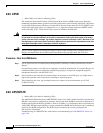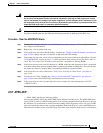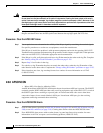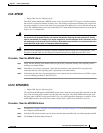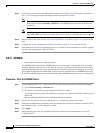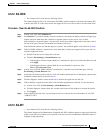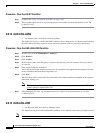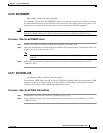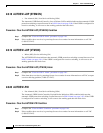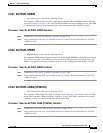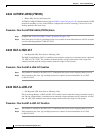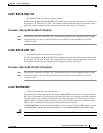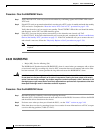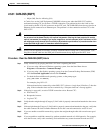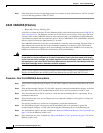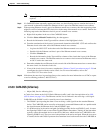
2-26
Cisco ONS 15327 Troubleshooting Guide, R3.4
March 2004
Chapter 2 Alarm Troubleshooting
Alarm Procedures
2.6.18 AUTOSW-LOP (STSMON)
• Not Alarmed (NA), Non-Service Affecting (NSA)
The Automatic UPSR Switch Caused by Loss of Pointer (LOP) condition indicates that automatic UPSR
protection switching occurred because of an LOP-P alarm (see page 2-80). If the UPSR is configured for
revertive switching, it will revert to the working path after the fault clears.
Procedure: Clear the AUTOSW-LOP (STSMON) Condition
Step 1 Complete the “Clear the LOP-P Alarm” procedure on page 2-81.
Step 2 If the condition does not clear, log onto http://www.cisco.com/tac for more information or call TAC
(1-800-553-2447).
2.6.19 AUTOSW-LOP (VTMON)
• Minor (MN), Service Affecting (SA)
The AUTOSW-LOP alarm indicates that automatic UPSR protection switching occurred because of an
LOP-V alarm (see page 2-81). If the UPSR is configured for revertive switching, it will revert to the
working path after the fault clears.
Procedure: Clear the AUTOSW-LOP (VTMON) Alarm
Step 1 Complete the “Clear the LOP-V Alarm” procedure on page 2-81.
Step 2 If the alarm does not clear, log onto http://www.cisco.com/tac for more information or call TAC to report
a service-affecting problem (1-800-553-2447).
2.6.20 AUTOSW-PDI
• Not Alarmed (NA), Non-Service Affecting (NSA)
The Automatic UPSR Switch Caused by Payload Defect Indication (PDI) condition indicates that
automatic UPSR protection switching occurred because of a PDI-P alarm (see page 2-93). If the UPSR
is configured for revertive switching, it will revert to the working path after the fault clears.
Procedure: Clear the AUTOSW-PDI Condition
Step 1 Complete the “Clear the PDI-P Condition” procedure on page 2-93.
Step 2 If the condition does not clear, log onto http://www.cisco.com/tac for more information or call TAC
(1-800-553-2447).



